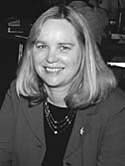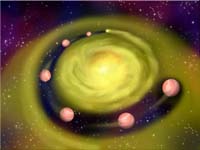
Contents of this page:
Carrol Moran named United Way Community Hero
Physics Department gets high ratings from graduate students
Science Illustration grads win awards in arts competition
Patricia Zavella helps organize binational health collaboration
![]()
November 19, 2001
Accolades
Carrol Moran named United Way Community Hero
 Carrol Moran, director
of UCSC's Educational Partnership Center, is one of 22 community leaders to receive
a 2001 Community Hero award from the United Way of Santa Cruz County.
Carrol Moran, director
of UCSC's Educational Partnership Center, is one of 22 community leaders to receive
a 2001 Community Hero award from the United Way of Santa Cruz County.
Every year for the past seven years, the United Way has issued a report card for
the community, looking at everything from the economy and education, to public safety
and the environment. As part of this Community Assessment Project, community members
nominate people they consider to be heroes for their work toward the project's 17
community goals. Moran received the 2001 Community Heroes award for helping Santa
Cruz meet the following goal: "Students will graduate from high school job-ready
or prepared for higher education."
Moran's award was announced at the Santa Cruz County Fair in September. Profiles
of recipients are included in the project's annual report, which was mailed to every
Santa Cruz household in November.
Physics Department gets high ratings from graduate students
In a recent survey of U.S. graduate students, the UCSC Physics Department received
the highest rating for overall student satisfaction of any physics program in the
country. The department received high marks in several categories, including mentoring,
program climate, and controlling the time it takes to earn a degree.
The survey, conducted by the National Association of Graduate-Professional Students,
was released in October. Participants were self-selected and included over 32,000
students and recent Ph.D.'s.
Physics professor David Belanger said the department has been working hard for several
years to build up its graduate program, and the efforts are clearly paying off.
"We have put a lot of effort into recruiting graduate students and creating
a supportive environment for them," said Belanger, who serves on the department's
committees on graduate student issues. "We're a small campus, so we have to
work at it, but I think departments can do a lot more to encourage graduate students
to come here."
The Physics Department has been particularly successful in its efforts to increase
the numbers of women and other underrepresented groups in the graduate program, Belanger
said. "The incoming class this year is almost half women, which in physics is
amazing," he said.
In April, Belanger will give an invited talk to a forum on graduate education at
the American Physical Society meeting in Albuquerque
Science Illustration grads win awards in arts competition
 |
| "The Core Accretion Theory of Planet Formation" by Meg Stalcup |
Stalcup received the first place award in the Student Science Division Animation category for "Red Shift Theory of Planet Detection," and third place in the Student Science Division for "Core Accretion Theory of Planet Detection." Both illustrations were done as classroom projects and appeared in the Science Communication Program's publication Science Notes.
Another graduate of the program, David Fierstein (class of '96), won first place in the professional Open Technology Division for his illustration "MUSE (MBARI ocean-observing system upper-water-column science experiment)."
This is not the first time that students and graduates of the illustration program have done well in this competition, said program coordinator Ann Caudle. Last year, students Adrienne Smucker and Emma Skurnick won second- and third-place awards and first honorable mention in the Student Science Division, and Fierstein won second place in the Professional Science Division.
"I'm so proud of our students," Caudle said. "I can't wait to see how the class of 2002 distinguishes itself."
Patricia Zavella helps organize binational health collaboration
Patricia Zavella, professor of Latin American and Latino studies, helped organize
Binational Health Week, a "historic partnership between the state of California
and the government of Mexico" designed to improve the health of the 3.2 million
Mexicans living and working in California. The collaboration was marked by activities
that took place October 12-19, including health-related messages focused on cancer,
immunizations, diabetes, nutrition, HIV, and work-related injuries, and an academic
conference that drew scholars from the United States and Mexico. Zavella was on the
planning committee that organized the conference, which was cosponsored by the UCSC
Chicano/Latino Research Center, and she participated in a press conference about
Binational Health Week. The collaboration is a program of the UC California Policy
Research Center.
Return to Front Page